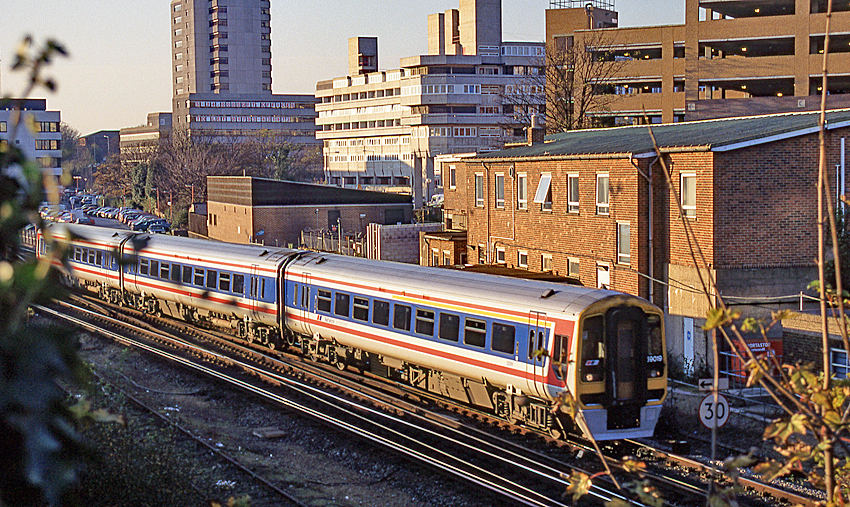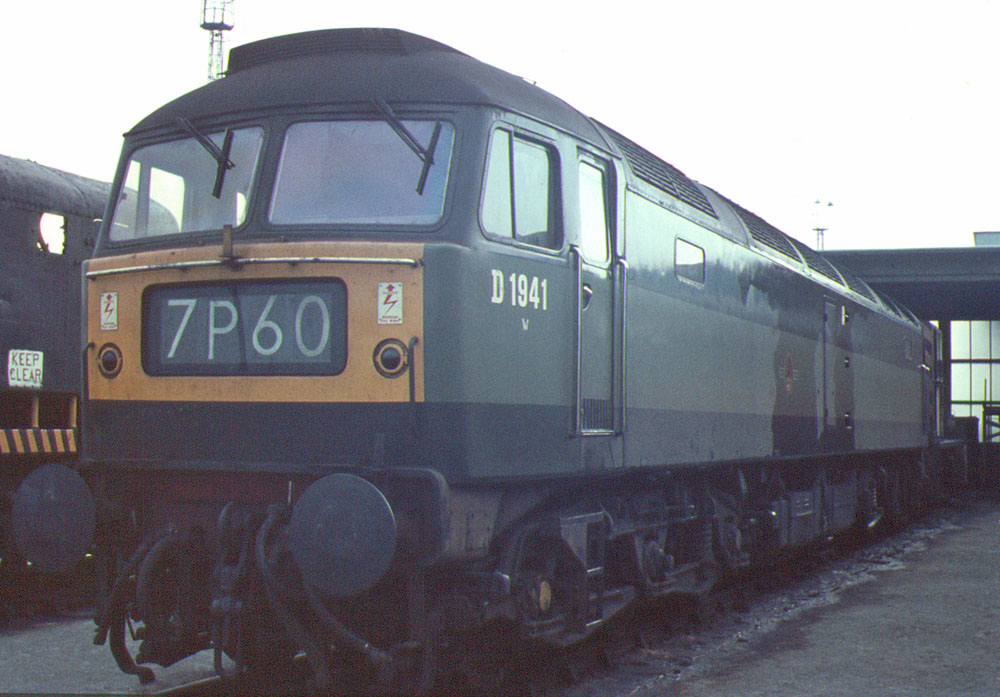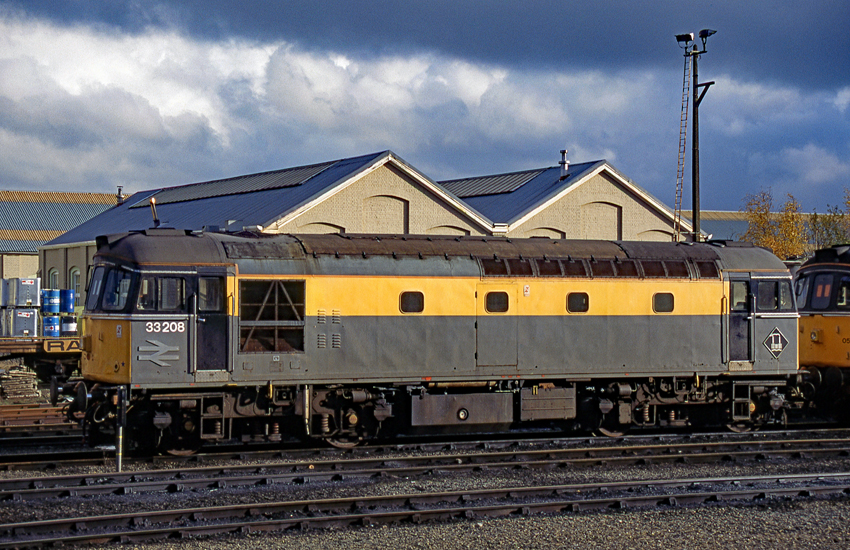|
Bournemouth Traction And Rolling Stock Maintenance Depot
Bournemouth Traction and Rolling Stock Maintenance Depot is a traction maintenance depot located in Bournemouth, South West England. The depot is situated on a spur off the South West Main Line and is to the east of Branksome station. The depot code is BM. History The site was originally the carriage sidings on the north side of the line between Bournemouth West Junction (the southern leg of the Branksome triangle) and . The carriage sidings had 11 roads before World War II (no. 1 road being closest to the main line); six more (12–16) were added during the war, with no. 17 road being added in 1956. The Southern Railway had provided a four-road carriage shed that straddled roads 7–10. Bournemouth West was closed as part of the 1966/67 electrification scheme. The line between Bournemouth West Junction and Gas Works Junction (the eastern leg of the Branksome triangle) was closed and lifted, and the carriage sidings were converted into a depot for the new electric mu ... [...More Info...] [...Related Items...] OR: [Wikipedia] [Google] [Baidu] |
Branksome, Dorset
Branksome () is a suburb of Poole in Dorset, England. The area consists of residential properties and also a number of commercial and industrial areas. It borders Parkstone, another small Poole suburb, to the west and north west, Alder Hills to the north east, Branksome Park (a more affluent forested area) to the south and Westbourne (a suburb of Bournemouth, Poole's conurbation neighbour) to the east. Overview Until the late 19th century the area was mainly unbuilt heath and woodlands. With the development and growth of nearby Bournemouth and later Poole the area became popular as a place to live, mainly because the area was relatively undeveloped but yet was within commuting distance between Poole and Bournemouth. With the development of the railways, Branksome continued to grow, served by the new Victorian line between Wimborne, Poole and Bournemouth. Branksome railway station which still serves the area today helped encourage a massive growth in the early 20th century. Mos ... [...More Info...] [...Related Items...] OR: [Wikipedia] [Google] [Baidu] |
British Rail Class 458
The British Rail Class 458 ( 5-JUP) is a class of electric multiple unit passenger trains built by Alstom at Washwood Heath between 1998 and 2002 for South West Trains. They were the first new fleet of trains to be delivered following the privatisation of British Rail. The order for the original fleet of 30 four-car trains was placed in 1997, and delivery of the first unit followed in October 1998. The fleet entered passenger service between 2000 and 2003 and is maintained at Wimbledon depot. They are part of Alstom's ''Coradia Juniper'' family of trains, which also includes Classes and . Between 2013 and 2016, the class was merged with the mechanically similar Class 460 fleet and extensively rebuilt to form a fleet of 36 five-car units—designated Class 458/5—to provide an increase in capacity on services into . The trains are now used by South Western Railway. In March 2021 South Western Railway announced that 28 Class 458 units would be refurbished and redeployed on ... [...More Info...] [...Related Items...] OR: [Wikipedia] [Google] [Baidu] |
British Rail Class 456
The British Rail Class 456 was an electric multiple unit passenger train introduced by Network SouthEast on inner-suburban services in South London to replace the elderly Class 416 2EPB units. Twenty-four two-car units were built by British Rail Engineering Limited's York Carriage Works in 1990 and 1991. Following the privatisation of British Rail, the fleet was sold to Porterbrook and operated by Southern up until late 2013, when they were transferred to South West Trains and heavily refurbished. Routes that were operated by Class 456 units will operated by new Class 701 Bombardier Aventra units in the future. Entry into service While originally approved for use by Network SouthEast (NSE) on services out of Waterloo, the 24 two-car units were first accepted into traffic as direct replacements for the 2EPB units on the Central Division of the Southern Region of British Rail. Units were delivered into traffic painted in NSE blue, red and white livery with cabs based on ... [...More Info...] [...Related Items...] OR: [Wikipedia] [Google] [Baidu] |
British Rail Class 455
The British Rail Class 455 is an electric multiple unit passenger train built by BREL between 1982 and 1985. It is operated on suburban services in Greater London and Surrey by South Western Railway, as well as formerly by Southern. Description The Class 455 was originally to be classified as the Class 510, at which point they were planned as a 750 V DC version of the . However, as the chopper control system at the time was not considered robust enough for the electrically rougher third rail Southern Region, they were fitted with a GEC Traction camshaft control systems instead. The Class 510 designation was discarded in favour of Class 455. A total of 505 carriages were built by British Rail Engineering Limited's Holgate Road carriage works and together with 43 existing trailers from Class 508s, formed 137 four-car sets. The 455s allowed the and to be withdrawn, as well as allowing the Class 508s to be transferred to the Merseyside network for which they were original ... [...More Info...] [...Related Items...] OR: [Wikipedia] [Google] [Baidu] |
British Rail Class 450
The British Rail Class 450 '' Desiro'' are third-rail DC electric multiple unit (EMU) passenger trains that began service during 2003. Used for outer-suburban services, they were built with standard and first-class accommodation. They have a maximum speed of . The ''Desiro UK'' family also includes units of Classes 185, 350, 360, 380 and 444. These trains are the most numerous in South Western Railway's fleet. In August 2017, the units transferred from their original operator South West Trains, which was owned by Stagecoach, to current operator South Western Railway, which is owned by FirstGroup and MTR Corporation. Introduction In April 2001, 785 vehicles were ordered by South West Trains in order to complete the replacement of its slam-door rolling stock, in accordance with its franchise commitment to do so by 2005, as the slam-door trains, many of which were more than 40 years old, did not meet modern health and safety requirements. Introduction to service was de ... [...More Info...] [...Related Items...] OR: [Wikipedia] [Google] [Baidu] |
British Rail Class 159
The British Rail Class 159 is a class of British diesel multiple unit trains of the Sprinter family, built in 1989–1992 by British Rail Engineering Limited (BREL)'s Derby Litchurch Lane Works as Class 158. Before entering traffic, the original 22 units were modified at Rosyth Dockyard to Class 159 to operate services from London Waterloo to Salisbury and Exeter St Davids, replacing various locomotive-hauled passenger trains. The units were originally branded by Network SouthEast as South Western Turbo. History and design In the late 1980s, the locomotive-hauled stock on Network SouthEast's ''West of England'' route from London Waterloo to Salisbury, Yeovil Junction and Exeter St Davids was in urgent need of replacement. The Class 50 locomotives were not suited to the stop-start nature of the route, and frequently broke down. Because of the long sections of single track west of Salisbury following the Beeching cuts, a single breakdown could cause chaos. Various options we ... [...More Info...] [...Related Items...] OR: [Wikipedia] [Google] [Baidu] |
British Rail Class 73
The British Rail Class 73 is a British electro-diesel locomotive. The type is unusual in that it can operate from the Southern Region's 650/750 V DC third-rail or an on-board diesel engine to allow it to operate on non-electrified routes. This makes it very versatile, although the diesel engine produces less power than is available from the third-rail supply so the locomotives are rarely operated outside of the former Southern Region of British Rail. Following the withdrawal and scrapping of the more powerful Class 74 electro-diesels in 1977, the Class 73 was unique on the British railway network until the introduction of the Class 88 electro-diesels in 2017. Ten locomotives have been scrapped. History The Southern Railway's expanding third rail electric passenger network (which had begun as far back as 1915) was until 1941 a purely passenger electric multiple unit (EMU) system. This was because it was necessary to have gaps in the third rail for level crossings, etc., w ... [...More Info...] [...Related Items...] OR: [Wikipedia] [Google] [Baidu] |
British Rail Class 47
The British Rail Class 47 or Brush Type 4 is a class of diesel-electric locomotive that was developed in the 1960s by Brush Traction. A total of 512 Class 47s were built at Brush's Falcon Works in Loughborough and at British Railways' Crewe Works between 1962 and 1968, which made them the most numerous class of British mainline diesel locomotive. They were fitted with the Sulzer 12LDA28C twin-bank twelve-cylinder unit producing though this was later derated to to improve reliabilityand have been used on both passenger and freight trains on Britain's railways for over 55 years. Despite the introduction of more modern types of traction, a significant number are still in use, both on the mainline and on heritage railways. As of December 2021, 78 locomotives still exist as Class 47s, including 31 which have been preserved. 33 further locomotives were converted to Class 57s between 1998 and 2004. Origins The Class 47 history begins in the early 1960s with the stated aim of ... [...More Info...] [...Related Items...] OR: [Wikipedia] [Google] [Baidu] |
British Rail Class 33
The British Rail Class 33, also known as the BRCW Type 3 or Crompton, is a class of Bo-Bo diesel-electric locomotives, ordered in 1957 and built for the Southern Region of British Railways between 1960 and 1962. They were produced as a more powerful Type 3 (1,550 bhp) development of the 1,160 bhp Type 2 Class 26. This was achieved, quite simply, by removing the steam heating boiler and fitting a larger 8 cylinder version of the previous 6 cylinder engine. This was possible because of the traffic requirements of the Southern Region: locomotive-hauled passenger traffic depended on seasonal tourist traffic and was heavier in the summer, when carriage heating was not needed. In the winter, their expected use was to be for freight. Thus, they became the most powerful BR Bo-Bo diesel locomotive. The perennially unreliable steam heating boiler could also be avoided. A total of 98 were built by the Birmingham Railway Carriage and Wagon Company (BRCW) and they were known as ... [...More Info...] [...Related Items...] OR: [Wikipedia] [Google] [Baidu] |
British Rail Class 09
The British Rail Class 09 is a class of 0-6-0 diesel locomotive designed primarily for shunting and short-distance freight trips along branch lines. The 26 locos are nearly identical to the more numerous Class 08 shunting locomotives but have different gearing, giving a higher top speed of 27.5 mph (44 km/h) at the expense of a lower tractive effort. They were introduced from 1959 to 1962 and latterly operated in the Southern Region of British Railways, although some of the class were originally allocated to depots in the Midlands and North. Further locomotives were converted from Class 08 in 1992 and, following this and privatisation in 1997, the class has been distributed much further afield. Passenger operations Although not normally considered for passenger work, Class 09s were recorded working passenger trains between Clapham Junction and Kensington Olympia when the booked Class 33 diesel was unavailable. They were also used on Railtours which needed to depart ... [...More Info...] [...Related Items...] OR: [Wikipedia] [Google] [Baidu] |
British Rail Class 423
The British Rail Class 423 ( 4 VEP), electric multiple unit passenger trains were mostly built by British Rail (BR) at York Works from 1967 to 1974, although the MBSOs and TSOs of the first 20, 7701-7720, were built at Derby Works. They have manually opening doors next to every seating row and were the last coaching stock built in this pattern for BR. They were mostly found working outer-suburban services in South London and rural services in Kent, Sussex and Hampshire, up to 2005 when they were finally replaced by Electrostar and Desiro units. The fleet had a working life of 38 years. Description Standard units Ordered in 1965, 194 standard four-car 4 VEP units were built between 1967 and 1974, numbered 7701-7894; subsequently becoming class 423 under TOPS. They were subsequently renumbered in the 1980s into the 30xx and 31xx series in order to make numbers TOPS compliant. Between 1988 and 1995 the units were internally facelifted. The work involved fitting fluorescent light ... [...More Info...] [...Related Items...] OR: [Wikipedia] [Google] [Baidu] |
8021_(6336760961).jpg)







